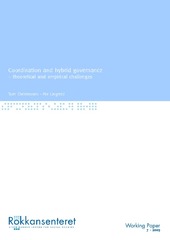| dc.contributor.author | Christensen, Tom | eng |
| dc.contributor.author | Lægreid, Per | eng |
| dc.date.accessioned | 2012-01-05T13:06:47Z | |
| dc.date.accessioned | 2020-12-10T06:31:18Z | |
| dc.date.available | 2012-01-05T13:06:47Z | |
| dc.date.available | 2020-12-10T06:31:18Z | |
| dc.date.issued | 2009-06 | eng |
| dc.identifier.issn | 1503-0946 | |
| dc.identifier.uri | https://hdl.handle.net/1956/5348 | |
| dc.description | This paper is part of the ongoing evaluation of the reform in the Norwegian employment and welfare administration and funded by the Norwegian Research Council. The paper is part of the sub-project in this evaluation named Welfare model,governance systems and NAV (the Norwegian acronym for the employment and Welfare administration), headed by Professor Tom Christensen. The paper was presented at 5TAD – The Future of Governance in Europe and the US, Workshop 6: Collaboration, Hybrid Governance and Networking. 11-13 June 2009, Washington DC | en |
| dc.description.abstract | Public organizations are increasingly hybrid and complex, trying to attend to numerous and partly conflicting structures and cultural elements at the same time. The different generations of public sector reforms – NPM and post-NPM – have accentuated these features, resulting in multiple-layer structural and cultural features from diverse generations of reforms. The paper covers the following main research questions: 1) analytically, how can we interpret the increasing tendency towards hybrid governance in terms of a transformative approach; 2) empirically, how is hybrid governance developing out of attempts to balance NPM and post-NPM considerations, particularly, how is it addressing the dichotomy between control and autonomy?; and 3) based on the transformative approach and insights into modern public sector reforms in general, how can we understand a modern reform that is typically hybrid in character? The case we focus on is the largest public sector reform ever in Norway, the reform of the welfare administration, which was decided on in the period 2001–2005 and implemented through 2009. The data are based on personal interviews with elite actors, public documents and various studies evaluating the reform. | en_US |
| dc.description.abstract | Mange offentlige organisasjoner blir mer komplekse og framstår som hybrider i sine bestrebelser på å håndtere mange og delvis motsetningsfulle strukturelle og kulturelle elementer på samme tid. Ulike generasjoner av reformer i offentlig sektor knyttet til New Public Management (NPM) og reformer i etterkant av NPM har forsterket disse utviklingstrekkene og ført til at det oppstår lagdelte strukturelle og kulturelle trekk som stammer fra ulike reformtiltak. Dette notatet behandler følgende problemstillinger: 1) analytisk, hvordan kan vi fortolke den økende tendensen til hybride organisasjonsformer ut fra et transformativt perspektiv?, 2) empirisk, hvordan utvikler hybride organisasjonsformer ut fra ønsket om å balansere NPM reformer og reformer i etterkant av NPM med særlig vekt på å håndtere spenningen mellom kontroll og autonomi?; og 3)basert på det transformative perspektivet og innsikt i moderne reformer i offentlig sektor generelt, hvordan kan vi forstå en moderne reform med typiske hybride trekk? Den reformen vi fokuserer på er NAV reformen, en av de største forvaltningsreformene i Norge. Den ble utformet i perioden 2001-2005 og gjennomføringen har pågått fra 2006. Dataene er basert på personlige intervju med aktører som har stått sentralt i reformprosessen, offentlige dokumenter og ulike studier som har undersøkt ulike sider ved reformen | en_US |
| dc.language.iso | eng | eng |
| dc.publisher | Stein Rokkan Centre for Social Studies | eng |
| dc.relation.ispartofseries | Working Paper | en |
| dc.relation.ispartofseries | 7-2009 | en |
| dc.title | Coordination and hybrid governance – theoretical and empirical challenges | eng |
| dc.type | Working paper | eng |
| dc.rights.holder | Copyright Stein Rokkan Centre for Social Studies. All rights reserved | |
| dc.subject.nsi | VDP::Samfunnsvitenskap: 200 | nob |
